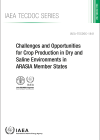More productive and resilient agriculture requires a major shift in the way water, soil, nutrients and other agricultural resources are managed. Isotopic techniques can track and quantify carbon, water and nutrient movement and their dynamics under diverse agroecosystems to improve smart agricultural practices.
Development of smart agriculture practices
Farmers need help to develop climate-smart agricultural practices that can adapt to and mitigate the impacts of climate change, but also have the potential to increase food production. Natural resources, such as land, water, soil and genetic resources, must be better managed so that more productive and resilient agriculture can be achieved. This should include such practices as conservation agriculture, which can yield many positive benefits: reduced soil erosion; better soil water retention and nutrient availability for crops; increased soil organic matter accumulation; and higher crop and animal productivity.
Together with the FAO, the IAEA aims to optimise and strengthen the capacities of Member States in using nuclear and isotopic techniques for more climate-smart agricultural practices, while supporting a more intensified crop production and better preservation of natural resources.
Climate-smart agricultural practices can help substantially reduce greenhouse gas emissions from livestock. Often, such practices provide benefits to farm economics and the environment alike. For example, better quality feed and feed balancing not only lower intestinal and manure greenhouse gas emissions, but also help increase productivity and thereby income. Improved breeding and animal health practices help reduce breeding overheads (animals assigned for breeding that are not yet producing though they are consuming resources) and related emissions.
Dual purpose farming by smallholders with livestock that yield both meat and milk emits fewer emissions than those produced by specialized, separate beef and dairy farming. Genetic characterization and marker assisted breeding and improved feeding can help improve meat quality and quantity from dairy animals.
How nuclear and isotopic techniques contribute
Nitrogen-15 and carbon-13 are used to track carbon, water and nutrient movement and dynamics in agroecosystems to assess the effects of conservation agriculture measures, ascertain stabilization and turnover of soil organic matter, and determine the fate of nitrogen and carbon in crop residues. They are used to study land degradation and soil erosion, so that appropriate soil and water conservation and management practices can be effectively targeted.
Incorporation in rumen (the first division of the stomach of a ruminant animal, such as cattle) microorganisms of nitrogen-14, phosphorus-32, phosphorus-33 or sulphur-35 is used to study the uptake and utilization of rumen microbial protein, and to identify better fodder crops. This can help improve feed conversion rates and energy utilization and thereby reduce greenhouse gases.Iodine-125 labelled progesterone in radioimmunoassay (a method for measuring very small amounts of a hormone in blood) is used to identify pregnant livestock and optimise animal breeding programmes.
Radiation hybrid mapping involving cobalt-60 contributes to characterizing livestock genomes, which helps identify advantageous gene traits, such as those responsible for disease resistance or the ability to thrive under climatic or nutritional stress.
Fallout radionuclides, such as caesium-137, lead-210 and beryllium-7, are used to determine soil redistribution over different time periods, ranging from a few days (Be-7), through decades (Cs-137), to around 100 years (lead-210). This is useful to detect trends in soil erosion and sedimentation rates.






